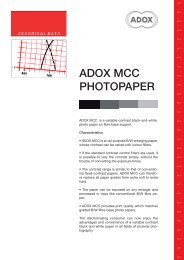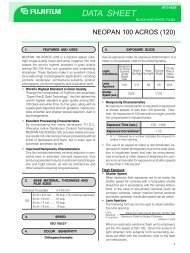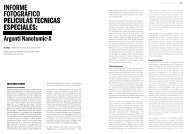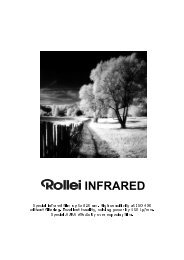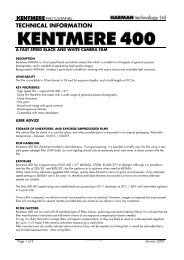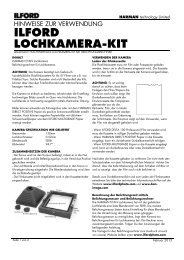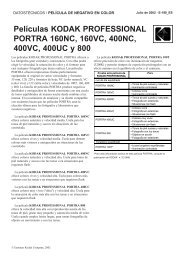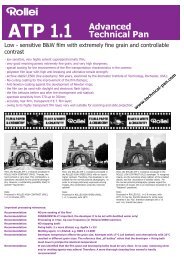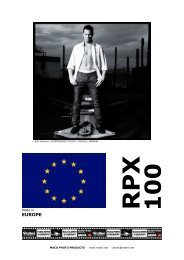Technical Data Agfa Professional Films - AgfaPhoto
Technical Data Agfa Professional Films - AgfaPhoto
Technical Data Agfa Professional Films - AgfaPhoto
Create successful ePaper yourself
Turn your PDF publications into a flip-book with our unique Google optimized e-Paper software.
<strong>Technical</strong> <strong>Data</strong><strong>Agfa</strong> <strong>Professional</strong> <strong>Films</strong>-1400 500In professional photography and creative imaging the mainconsiderations are quality, continuity and individuality. Forthese reasons the films for this area are measured by specialstandards. A film only satisfies these high standards if itsperformance is above-average. And it will only be accepted ifit achieves this performance with extreme accuracy, consistencyand with the maximum reliability. The wide range ofprofessional applications calls for a correspondingly wide rangeof different emulsions, whose characteristics must be designedexactly for specific areas of use.<strong>Agfa</strong> <strong>Professional</strong> films are specified to satisfy these exceptionalstandards. They combine the maximum quality withmaximum reliability: optimum colour saturation and tonaldefinition, exact contrast ranges, exemplary grey balance, thefinest detail rendition in the critical highlight and shadowareas, extreme sharpness and fine granularity, and uniformexposure requirements at short and long exposure times.Two examples of extremely tight production tolerances:speed:± 0.5 DIN = ± 1/6 stopcolour balance: ± 5 CC filter units<strong>Agfa</strong>color Optima 100<strong>Agfa</strong>color Optima 200<strong>Agfa</strong>color Optima 400<strong>Agfa</strong>color Portrait 160<strong>Agfa</strong>chrome RSX II 50<strong>Agfa</strong>chrome RSX II 100<strong>Agfa</strong>chrome RSX II 200<strong>Agfa</strong>pan APX 100<strong>Agfa</strong>pan APX 400 *<strong>Agfa</strong> Scala 200x*new generation (as of 2003)is used under license of <strong>Agfa</strong>-Gevaert AG
<strong>Agfa</strong>color Optima withEYE VISION technologyA film's colour rendition is governed by a number of factors. Theemulsions' spectral sensitivity or sensitisation is particularlyimportant, when it comes to reproducing true-to-nature colourswith the maximum accuracy. By means of the EYE VISIONtechnology incorporated in all the <strong>Agfa</strong>color Optima films, it isnow possible to match, to a large extent, the films' sensitisationto the colour perception of the human eye. The effect is shownschematically in the following diagrams. The EYE VISIONtechnology achieves more accurate colour fidelity, and largelyeliminates the colour falsifications present in films withconventional sensitisation such as:• an unpleasant green cast with fluorescent light (e.g. neon tubes),• a shift towards red in certain blue-coloured flowers (hortensia,clematis, delphinium etc.),• the brown rendition of particular green fabric colours,• the absence of texture in certain red colours (e.g. roses).Spectral sensitivity of the eyeblue green red400 450 500 550 600 650 nmSpectral sensitivity of the film emulsions400 450 500 550 600 650 nm<strong>Agfa</strong> <strong>Professional</strong> film range<strong>Agfa</strong>color negative films:• Optima 100• Optima 200• Optima 400• Portrait 160<strong>Agfa</strong>chrome reversal films:• RSX II 50• RSX II 100• RSX II 200<strong>Agfa</strong>pan black and white negative films:• APX 100• APX 400<strong>Agfa</strong> black and white reversal films:• Scala 200xOPTIMAblue green redpreviouslyInformation on the performance characteristics of<strong>Agfa</strong> <strong>Professional</strong> filmsSensitivity (speed)Sensitivity is a measure of the response of a film to light exposure.The speed of films is based on the minimum exposure required forproducing optimum tone reproduction. It is determined accordingto international standards for b&w, colour negative, and colourreversal films that specify the exposure, chemical processing anddensitometer.The figure given on the pack applies however to the exposuretime range of 1 s to 1/10 000 s. Absolutely no sensitivity deviationsoccur with any <strong>Agfa</strong> films within this range.Reciprocity effectThe effect of an exposure of silver halide based films to light isthe product of light intensity × time of exposure, i.e. E = l × T.This reciprocity law (first defined by Bunsen and Roscoe and alsoknown as the Schwarzschild effect) holds that a 1/100 secondexposure time at a light intensity of 1 lux will yield the sameresults as an exposure time of 1 second at 100 lux. However, atintensities significantly below or above the range in which reciprocityis maintained with a given film, more exposure will berequired to achieve the same result. This is known as reciprocityfailure. With colour films the failure of reciprocity tends to bedifferent for the blue, green and/or red recording layers resultingin a shift in colour and colour contrast balance.Appropriate information about reciprocity failure and the meansfor compensation through exposure adjustments and/or use ofcolour filters is given in the technical data section.Colour sensitivityThe spectral sensitivity of <strong>Agfa</strong> colour negative, colour reversaland black and white <strong>Professional</strong> films covers the entire rangeof visible radiation.Colour balanceDaylight has a completely different colour temperature to theartificial light produced by the halogen and incandescent lampscommon in practice. (An exception is formed by the halogenmetal vapour lamps with daylight characteristics, e.g. OsramHMI and Philips MSR lights for professional use.)Colour films detect variations in the colour temperature muchmore accurately than the human eye, which receives an overallcolour impression and largely balances the differences. For thisreason colour films have to be sensitised to a certain kind ofsubject light, i.e. depending on the film type a particular colourtemperature is fixed as reference white-point during manufacture.All the <strong>Agfa</strong>color and <strong>Agfa</strong>chrome <strong>Professional</strong> films are matchedto daylight , and are designed for the spectral radiation of mixedsunlight (colour temperature approx. 5500 Kelvin). Photographyin this type of light does not require filtration, i.e. the resultswith all the films have an even, neutral colour balance.If however the colour temperature of the subject light variesdistinctly, this has to be counteracted for colour reversal filmsby camera correction filters, which prevent colour casts.2 F-PF-E3
Colour temperatureFilter colourtoo high (> 5 500 K) yellow-redtoo low (< 5 500 K) blueThe exposure must also be adjusted depending on the filterstrength.Light sources and filtersDaylightPractical correction examples Filter CorrectionHigh colour temperature, e. g. 5700 KLandscapes, portraits with cloudy sky, 81 A + 1 / 3 stopcloudless mountainscapesLow colour temperature, e. g. 5 300 KLandscapes, portraits at dawn or dusk82 A + 1 / 3 stopArtificial light<strong>Agfa</strong> <strong>Professional</strong> films can also be used in artificial light withsuitable filtration.Light source Filter Exposure correction(f-stops)Photo lamps 3 400 K 80 B + 1 1 / 3Photo lamps 3 200 K 80 A + 2Electronic flashElectronic flash frequently works with a colour temperature of5500 K (average daylight). There are however equipment andapplications for which the flash tube colour temperature variesfrom this average figure. In these cases a test is advisable. Bearin mind that with longer exposure times the electronic flashlight can be influenced by any other light sources present, sothat a mixed-light situation is created.Fluorescent tubesThe spectral distribution of radiation of fluorescent light tubesvaries quite considerably according to manufacturer, lamp typeand lamp age. Exact filter information is therefore not possible.To ensure optimum colour rendition in spite of this, test shotsare advisable.The following correction figures can only serve as guides for theright filtration in practice, and apply to colour reversal films.They are based on results gained by experience. However theexposure times can be lengthened so much by the filtration thata further correction is necessary, due to the reciprocity effect.Fluorescent lamp type FilterExposure correction(f-stops)Daylight (D) 50 R + 1White (W) 40 M + 2 /3Cold-white (KW) 20 C + 40 M + 1Warm-white 40 M + 10 Y + 1Mixed lightWhen you take pictures with different light sources, specialattention must be paid to the colour temperature of the mainlight source for the correction filtration. The precise colour renditionand – if required – specific colour temperature effectsshould definitely be found with test shots.Other filtersUV-blocking filter<strong>Films</strong> are also sensitive to the UV content of daylight. UVblockingfilters are therefore often used to prevent colour shiftsand unsharpness. This is unnecessary for all the <strong>Agfa</strong> <strong>Professional</strong>colour films, because a UV-blocking layer is alreadyincorporated in the emulsion. An extra filter is neverthelessuseful to protect the lens against physical damage.Polarisation filterThis filter is used firstly to cut down reflections, e.g. from glassor water (not metal), and secondly to create special effects (e.g.more vivid sky blue). A certain lengthening factor must be appliedto the exposure, depending on the filter type (see the instructionsfor use of the camera or filter).Filters for black and white photographyAll the correction and contrast filters standard in black andwhite photography can be used with <strong>Agfa</strong>pan films.Examples:Yellow filter To heighten cloud contrastOrange filter For clear long-distance viewsRed filter To “dramatise” an atmosphereTo compensate for the loss in speed caused by these filters, themanufacturer’s lengthening factors must be applied. Filters forblack and white films are not suitable for colour photography.They cause strong colour shifts.Storage of unprocessed filmsHigh temperatures and high atmospheric humidity can impairthe photographic characteristics of a film material, in particularits speed and colour balance. Harmful fumes such as formalin orother fumes given off mainly by glues or cosmetics shoulddefinitely be avoided. <strong>Films</strong> are best stored in the original pack,because this protects them against humidity and fumes. Storagein a refrigerator (below +10 °C / 50 °F) or in a deep freezer(below 0 °C / 32 °F) is an effective way of stabilising films’photographic properties for a very long time. However wait longenough for the film to come up to room temperature after it hasbeen taken out of refrigeration, since otherwise condensationcan form on the cold material. (Recommended acclimatisationtime: with refrigerator approx. 2 hours, with deep freezer approx.8 hours).Cameras do not provide sufficient protection against theseharmful effects. It is therefore advisable to keep a camera cool,dry and airtight when a film is loaded (if necessary in apolyethylene bag).Once a film has been exposed, the above precautions forunexposed films are even more important. Exposed films shouldbe kept cool and dry, or even better processed as soon as possibleafter exposure. This ensures that these effects have no time totake place.F-PF-E3 3
Directions for X-ray inspectionsThe basic rule is that films are sensitive to X-rays, and this sensitivityincreases with the film’s sensitivity. The X-ray inspection equipmentused on many airports marked “Film Safe” does not affect filmsunder normal circumstances. Nevertheless, for safety’s sake filmsshould not be handed in as luggage but kept in hand luggage. Incases of doubt a visual inspection is preferable.ProcessingFilm type Process Compatible Processwith process data sheet<strong>Agfa</strong>color AP 70 C-41 C-70,negative films C-7172<strong>Agfa</strong>chrome AP 44 E-6 C-44slide films<strong>Agfa</strong>pan For developing methods, types C-SW16B/W filmsetc. see data sheet<strong>Agfa</strong> Scala 200x Special Scala process in authorisedB/W slide film Scala labs only (see internet: www.agfa.com)The <strong>Technical</strong> <strong>Data</strong> sheets listed contain detailed informationon the processing of the relevant films.Pushed/pulled processing of slide filmsIf the first development time is changed, the photographic speedalso changes. Lengthening the time leads to an increase in speed(so-called pushing), shortening the time reduces it (pulling).This is a correction method often used in professional photography,with the aim of a fine adjustment of the colour densityor a deliberate change in speed.The <strong>Agfa</strong>chrome RSX II <strong>Professional</strong> films feature exceptio-nallygood push/pull stability. Up to a speed adjustment of ± 1 stop(1), the neutrality of colour rendition is preserved in full. Evenan increase in speed of up to two stops only has a very slighteffect on the colour balance.<strong>Agfa</strong> Scala 200x <strong>Professional</strong>With the standard Scala process: ISO 200/24°.The speed of the <strong>Agfa</strong> Scala 200x can be varied in steps by pushing orpulling the process. The contrast, maximum density and granularitysimultaneously vary in comparison to the standard process.Step Push 1 Push 2 Push 3 Pull 1Speed (ISO) 400/27° 800/30° 1600/33° 100/21°Contrast increasingly steeper flatterMaximum density decreasing increasingGranularity increasingly coarse-grained finerApplicationsVarying the speed and the contrast is useful in many fields.Pushed processinga) To increase the speed:– with poor lighting / available light– with lenses with long focal lengths and / or low power– with fast-moving subjectsb) To steepen the contrast:– for dramatic effectsPulled processinga) To decrease the speed:– for higher maximum density– for finer granularity (–10 % at ISO 100/21°)b) To flatten the contrast:– for reproductions of X-rays– for duplicates of BW negatives and original ScalatransparenciesStorage of processed filmsThe same precautions apply to processed films:• under 25° C• 30 to 60 % relative humidity• protected from fumes• darknessFurther processingEvaluating negativesNegatives of colour and black and white films can be appraisedin basically the same way. The most important criterion is theshadow area. Thin coverage in comparison to the mask colorationshould be apparent on colour negatives.RetouchingIn portrait photography and in some other areas as well, theretouching of processed film material is common. The film typessuitable for this treatment incorporate a retouchable back (onlyroll film and sheet film), i.e. they are suitable for pencil and liquidretouching (retouching paints). Only the <strong>Agfa</strong>color XPS 160 rollfilm has a retouchable emulsion.Evaluating slidesThe colour balance of <strong>Agfa</strong>chrome <strong>Professional</strong> films is designedfor the viewing light specified in ISO 3664. The main features ofthis standard:• colour temperature 5000 K• mean luminance 1400 cd/m 2• uniformity of luminance at least 75 %Comparisons should be made in principle on one and the samelight box, because there may be considerable variations in lightcolour and intensity between different boxes.Use of slide films in scannersAll <strong>Agfa</strong>chrome <strong>Professional</strong> films are reprographically compatible.The high-grade photographic characteristics of this materialare therefore transferred completely, even if only the standardscanner setting is used.4 F-PF-E3
Specific information on the productThe charts and figures shown on page 6 to 9 are briefly explainedbelow, and the conditions of measurement are also described.All the figures are averages of various production runs. For someemulsion batches they may vary slightly from each other, inspite of the very tightly maintained tolerances.Spectral sensitivitiesThe chart indicates the colour sensitivity of an unprocessed film.Reference: – equal-energy spectrumReading density: – 1.0 above minimum densityAbsorption of the emulsion dyesThe chart indicates the relative effect of a processed film ontransmitted light. For colour negative films this is a measure forthe spectral sensitisation of the following printing material, forcolour slide films it is a measure for the viewer’s eye underdefined standard light conditions.Reference: – neutral subject with medium brightness– minimum densityColour density curvesThe chart indicates the dye densities of a processed film inrelation to the exposure.Reference: – exposure: daylight 1/100 second– process: AP 70/C-41 and AP 44/E-6– densitometry: Status A and Status MSharpnessThis is an MTF (Modulation Transfer Function) chart, which indicatesthe image sharpness. The higher the transfer factor in %, the lowerthe transfer losses are.Reference: – exposure: daylight– densitometry: visual filter (V λ)GranularityGranularity is the irrregular density structure of an exposed andprocessed area of film. The figure is based on the RMS (rootmean-square)measuring method. The smaller the figure is, thefiner grain the film has. The RMS measuring method is intendedto match an instrumentally found figure with the visual perceptionof the film granularity.Reference: – exposure: daylight– densitometry: visual filter (V λ)– measurement: diffuse density 1.0;48 µm reading apertureResolving powerThis is given as a figure in the appendix. It indicates the resolutionlimit in the rendition of adjacent finest details (e.g. lines in amatrix).The resolving power is a purely visual criterion, which is greatlyinfluenced by the contrast range.Layer designThe continuous further development of coating technologypermits thinner, and simultaneously more layers. The thinnerlayers enhance the sharpness, and the extra layers haveseparating, blocking, protecting and filtering functions. Theyoptimise not only the colour rendition, but also the sharpnessand storage life as well. A schematic representation is shown onright, taking the Optima 100 as an example.SupercoatUV filter layerBlue-sensitive yellow layersYellow filter layerGreen-sensitive magenta layersRed filter layerRed-sensitive cyan layersAnti-halo layerBaseTotal layer thickness (without base): 16 µm(Other films: see pages 6 to 9)Emulsion baseThe film base is made of acetyl cellulose or polyester. The typeand thickness of the base are given on pages 6 to 9.Reference: – lines per mm at contrast range 1.6 : 1 or 1000 : 1F-PF-E3 5
Film identificationProcess colour coding on 35 mm filmsMargin bars on the cartridge• red Process AP 70/C-41• blue Process AP 44/E-6• grey B/W negative processingProcess colour coding on roll filmsOverprint at end of backing paper• yellow Process AP 70/C-41• blue Process AP 44/E-6• black B/W negative processingExposed margin marks1. Film type + emulsion number2. Frame numbering•On 35 mm films after 2 blank exposurescontinuous frame numbering startingwith "1" and "1A" up to 12A, 24A or36A•On roll films continuous double-sidedframe numbering from 1-12 or 41-61(120 roll film), or 1-25 or 41-83 (220roll film).Reciprocity effect3. Symbol marks on colour negative filmsSymbols are exposed on to 35 mm androll films to identify the film generation.Oprima 100 4 red squaresOprima 200 4 red trianglesOprima 400 2 red squaresPortrait 160 4 green squaresNotch coding on sheet filmsThe film type can be identified from thetype of notching. The emulsion side is facingthe viewer when the notching in uprightformat is at top right.<strong>Agfa</strong>chrome RSX II 100<strong>Agfa</strong>pan APX 100<strong>Agfa</strong> Scala 200x<strong>Agfa</strong>color Portrait 160Spectral sensitivity→ lg SensitivitySpectral density→ Spectral densitySharpness→ Transfer factor (%)2.01.00-01.-2.01.001501005030Blue Green Red400 500 600 700→ Wavelength (nm)Medium densityMinimum density400 500 600 700→ Wavelength (nm)Colour negative films<strong>Agfa</strong>color Optima 100 <strong>Agfa</strong>color Optima 200Exposure reading (seconds) 1/10 000-1 10 100 1/10 000-1 10 100Exposure adjustment (f-stops) 0 + ½ + 1½ 0 + 1 + 2<strong>Agfa</strong>color Optima 400 <strong>Agfa</strong>color Portrait 160Exposure reading (seconds) 1/10 000-1 10 100 1/10 000-1 10 100Exposure adjustment (f-stops) 0 + 1 + 2 0 + 1 + 2Colour slide films<strong>Agfa</strong>chrome RSX II 50 <strong>Agfa</strong>chrome RSX II 100Exposure reading (seconds) 1/10 000-1 10 100 1/10 000-1 10 100Exposure adjustment (f-stops) 0 + ½ + 1 0 + ½ + 1Filtration (CC filter) 0 05B 10B 0 05B 10B<strong>Agfa</strong>chrome RSX II 200Exposure reading (seconds) 1/10 000-1 10 100Exposure adjustment (f-stops) 0 + 1 + 2Filtration (CC filter) 0 075Y 15Y 05CB/W negative films<strong>Agfa</strong>pan APX 100 <strong>Agfa</strong>pan APX 400Exposure reading (seconds) 1/10 000-½ 1 10 100 1/10 000-1 1 10 100Exposure adjustment (f-stops) 0 + 1 + 2 + 3 0 + 1 + 2 + 3Developing adjustment (%) 0 – 10 – 25 – 35 0 – 10 – 25 – 35B/W slide film<strong>Agfa</strong> Scala 200xExposure reading (seconds) 1/10 000-½ 1 10 100Exposure adjustment (f-stops) 0 + ½ + 1 + 220102 3 5 10 20 30 50 100→ Lines per mmColour density curves→ Density4.03.02.01.00BlueGreenRed–3.0 –2.0 –1.0 0 +1.0→ lg exposure (Lx · s)Speed: ISO 160/23°Granularity (x 1000): RMS 3.5Resolving powerContrast 1000 : 1 150 lines/mmContrast 1.6 : 160 lines/mmLayer thickness: 18 µmFilm base: 135 = 120 µm120/220 = 95 µmDX codingCartridge code: 135-24 = 00786 3135-36 = 00786 4Negative code: 49 – 026 F-PF-E3
<strong>Agfa</strong>color Optima 100Spectral sensitivity→ lg Sensitivity2.01.0Blue Green Red0<strong>Agfa</strong>color Optima 200Spectral sensitivity→ lg Sensitivity2.01.0Blue Green Red0<strong>Agfa</strong>color Optima 400Spectral sensitivity→ lg Sensitivity2.0Blue Green Red1.00-1.0400 500 600 700→ Wavelength (nm)-1.0400 500 600 700→ Wavelength (nm)400 500 600 700→ Wavelength (nm)Spectral density→ Spectral density2.01.00Sharpness→ Transfer factor (%)150100503020Medium densityMinimum density400 500 600 700→ Wavelength (nm)Spectral density→ Spectral density2.01.00Sharpness→ Transfer factor (%)150100503020Medium densityMinimum density400 500 600 700→ Wavelength (nm)Spectral density→ Spectral density2.01.00Sharpness→ Transfer factor (%)150100503020Medium densityMinimum density400 500 600 700→ Wavelength (nm)102 3 5 10 20 30 50 100→ Lines per mm102 3 5 10 20 30 50 100→ Lines per mm102 3 5 10 20 30 50 100→ Lines per mmColour density curvesColour density curvesColour density curves→ Density4.03.0Blue→ Density4.03.0Blue→ Density4.03.0BlueGreen2.0GreenRed2.0GreenRed2.0Red1.01.01.00- 4.0 - 3.0 - 2.0 -1.0 0 +1.0→ lg exposure (Lx · s)0- 4.0 - 3.0 - 2.0 -1.0 0 +1.0→ lg exposure (Lx · s)0- 4.0 - 3.0 - 2.0 -1.0 0 +1.0→ lg exposure (Lx · s)Speed: ISO 100/21°Granularity (x 1000): RMS 4.0Resolving powerContrast 1000 : 1 140 lines/mmContrast 1.6 : 150 lines/mmLayer thickness: 16 µmFilm base: 135 = 120 µm120 = 95 µmDX codingCartridge code: 135-24 = 00798 3135-36 = 00798 4Negative code: 49 – 14Speed: ISO 200/24°Granularity (x 1000): RMS 4.3Resolving powerContrast 1000 : 1 130 lines/mmContrast 1.6 : 150 lines/mmLayer thickness: 18 µmFilm base: 135 = 120 µm120 = 95 µmDX codingCartridge code: 135-24 = 00799 3135-36 = 00799 4Negative code: 49 – 15Speed: ISO 400/27°Granularity (x 1000): RMS 4.5Resolving powerContrast 1000 : 1 130 lines/mmContrast 1.6 : 150 lines/mmLayer thickness: 19 µmFilm base: 135 = 120 µm120/220 = 95 µmDX codingCartridge code: 135-24 = 00794 3135-36 = 00794 4Negative code: 49 – 10F-PF-E3 7
<strong>Agfa</strong>chrome RSX II 50Spectral sensitivity→ lg Sensitivity2.01.0<strong>Agfa</strong>chrome RSX II 100Spectral sensitivity→ lg Sensitivity2.01.0<strong>Agfa</strong>chrome RSX II 200Spectral sensitivity→ lg Sensitivity2.01.00BlueGreenRed0BlueGreenRed0BlueGreenRed- 0.1400 500 600 700→ Wavelength (nm)-1.0400 500 600 700→ Wavelength (nm)-1.0400 500 600 700→ Wavelength (nm)Spectral density→ Spectral density1.5Visual grey1.00.5Yellow Magenta CyanSpectral density→ Spectral density1.5Visual grey1.00.5Yellow Magenta CyanSpectral density→ Spectral density1.5Visual grey1.00.5Yellow Magenta Cyan0400 500 600 700→ Wavelength (nm)0400 500 600 700→ Wavelength (nm)0400 500 600 700→ Wavelength (nm)Sharpness→ Transfer factor (%)150100503020Sharpness→ Transfer factor (%)150100503020Sharpness→ Transfer factor (%)150100503020102 3 5 10 20 30 50 100→ Lines per mm102 3 5 10 20 30 50 100→ Lines per mm102 3 5 10 20 30 50 100→ Lines per mmColour density curves→ Density4.0GreenRedBlue3.02.0Colour density curves→ Density4.0Blue3.02.0GreenRedColour density curves→ Density4.03.02.0BlueRedGreen1.01.01.00-3.0 -2.0 -1.0 0 +1.0 +2.0→ lg exposure (Lx · s)Speed: ISO 50/18°Granularity (x 1000): RMS 10.0Resolving powerContrast 1000 : 1 135 lines/mmContrast 1.6 : 155 lines/mmLayer thickness: 25 µmFilm base: 135 = 120 µm120 = 95 µmDX codingCartridge code: 135-36 = 00089 40-3.0 -2.0 -1.0 0 +1.0 +2.0→ lg exposure (Lx · s)Speed: ISO 100/21°Granularity (x 1000): RMS 10.0Resolving powerContrast 1000 : 1 130 lines/mmContrast 1.6 : 150 lines/mmLayer thickness: 25 µmFilm base: 135 = 120 µm120 = 95 µmsheet film = Acetate 190 µmDX codingCartridge code: 135-36 = 00057 40-3.0 -2.0 -1.0 0 +1.0 +2.0→ lg exposure (Lx · s)Speed: ISO 200/24°Granularity (x 1000): RMS 12.0Resolving powerContrast 1000 : 1 120 lines/mmContrast 1.6 : 150 lines/mmLayer thickness: 27 µmFilm base: 135 = 120 µm120 = 95 µmDX codingCartridge code: 135-36 = 00118 48 F-PF-E3
<strong>Agfa</strong>pan APX 100Spectral sensitivity→ lg Sensitivity2.01.0<strong>Agfa</strong>pan APX 400Spectral sensitivity→ lg Sensitivity2.01.0<strong>Agfa</strong> Scala 200xSpectral sensitivity→ lg Sensitivity2.01.0000→ Density→ Transfer factor (%)-1.03.02.01.0400 500 600 700→ Wavelength (nm)Characteristic curve0-4.0 -3.0 -2.0 -1.0 0 +1.0 +2.0→ lg exposure (Lx · s)Sharpness150100503020→ Density→ Transfer factor (%)-1.03.02.01.0400 500 600 700→ Wavelength (nm)Characteristic curve0-4.0 -3.0 -2.0 -1.0 0 +1.0 +2.0→ lg exposure (Lx · s)Sharpness150100503020→ Transfer factor (%)–1.0150100503020400 500 600 700→ Wavelength (nm)Characteristic curves→ Density3.02.01.0Pull 1StandardPush 1Push 2Push 30-3.0 -2.0 -1.0 0 +1.0 +2.0 +3.0→ lg exposure (Lx · s)Sharpness→ Negative contrast (C )100.750.700.650.602 3 5 10 20 30 50 100→ Lines per mmGamma-time curvesRODINAL SPECIALSTUDIONAL LIQUIDREFINALRODINAL 1+25RODINAL 1+500.55 2 4 6 8 10 12 14 16 18→ Developing time (min.)Speed: ISO 100/21°Granularity (x 1000): RMS 9.0Resolving powerContrast 1000 : 1 150 lines/mmLayer thickness: 7 µmFilm base: 135 = 120 µm120 = 95 µmsheet film = PET 175 µmDX codingCartridge code: 135-24 = 00023 3135-36 = 00023 4→ Negative contrast (γ)100.750.700.650.602 3 5 10 20 30 50 100→ Lines per mmGamma-time curvesREFINALRODINAL SPECIALSTUDIONAL LIQUIDRODINAL 1+250.55 2 4 6 8 10 12 14 16 18→ Developing time (min.)Speed: ISO 400/27°Granularity (x 1000): RMS 14.0Resolving powerContrast 1000 : 1 110 lines/mmLayer thickness: 10 µmFilm base: 135 = 120 µm120 = 95 µmDX codingCartridge code: 135-36 = 00019 4→ Density→C103.43.23.02.82.62.42.22.02.01.81.61.41.21.00.80.6ISO:2 3 5 10 20 30 50 100→ Lines per mmContrast/maximum density withpushed/pulled processing100/21°Pull 1Maximum densityContrast200/24° 400/27°Push 1800/30°Push 21600/33°Push 3Speed: ISO 200/24°Granularity (x 1000): RMS 11.0Resolving power (Reference: ISO 200°)Contrast 1000 : 1 120 lines/mmContrast 1.6 : 150 lines/mmLayer thickness: 7 µmFilm base: 135 = 120 µm120 = 95 µmsheet film = PET 175 µmDX codingCartridge code: 135-36 = 00024 4F-PF-E3 9
General instructions of B/W film processingIt is a well-known fact that the results of development depend not only on the time, temperature and type of solution, but also on theprocess method used (tray, small tank, drum, large tank). To obtain reproducible results, the following instructions should befollowed:• For processing in small tanks, agitate (tilt) the tank continuously for the first minute, and then tilt every thirty seconds. Avoiddeveloping times under three minutes.• For processing in drums (rotary process), choose a speed greater than 30 rpm (changing the direction of rotation). Avoid developingtimes under three minutes.The development times given below are guides only, and are based on an average contrast of γ = 0.65. Variations are possible,depending on the individual processing conditions.Processing <strong>Agfa</strong>pan APX 100DeveloperDeveloping time in min.18 °C 20 °C 22 °C 24 °CProcessing in small tanks/traysRefinal 8 6 4 ½ 4Rodinal 1 + 25 10 8 6 5Rodinal 1 + 50 20 17 14 12Rodinal Special 5 4 3 –Studional Liquid 5 4 3 –Processing in tanksAtomal FF 10 8 6 5Refinal 9 7 5 4Exposure index <strong>Agfa</strong>pan APX 100Developer Time* SpeedRefinal 6 min. ISO 125/22°Rodinal 1 + 25 8 min. ISO 125/22°Rodinal 1 + 50 17 min. ISO 160/23°Rodinal Special 4 min. ISO 125/22°Studional Liquid 4 min. ISO 125/22°*) Processing in small tank at 20 °CProcessing <strong>Agfa</strong>pan APX 400DeveloperDeveloping time in min.18 °C 20 °C 22 °C 24 °CProcessing in small tanks/traysRefinal 7 5 4 3Rodinal 1 + 25 11 ½ 10 9 8Rodinal 1 + 50 – 30 27 ½ 25Rodinal Special 7 6 4 ½ 4Studional Liquid 7 6 4 ½ 4Tetenal Ultrafin Plus 16Kodak T-MAX 12Kodak D76/Ilford ID11 12Processing in tanksAtomal FF 12 ½ 10 6 6Refinal 6 ½ 5 4 3Exposure index <strong>Agfa</strong>pan APX 400Developer Time* SpeedRefinal 5 min. ISO 400/27°Rodinal 1 + 25 10 min. ISO 320/26°Rodinal 1 + 50 30 min. ISO 320/26°Rodinal Special 6 min. ISO 400/27°Studional Liquid 6 min. ISO 400/27°*) Processing in small tank at 20 °CFurther processing details are given in the <strong>Technical</strong> <strong>Data</strong> Sheet P-SW16.ISO 9001 quality certificateSince 1994 the photo-chemical production department of <strong>Agfa</strong>-Gevaert AG has possessed the ISO 9001 certificate for its qualitymanagement system, as awarded by Lloyd’s Register for Quality Assurance Ltd. (LRQA), London.The ISO 9001 standard defines the principles of quality assurance, including concepts and criteria for customer-based qualityplanning, specifications for each stage of production, and also systems for error prevention and for the continuous enhancement ofproduction techniques.Comprehensive documentation of all the tests and their regular monitoring by internal and external auditors ensures that the productquality is consistently based on objectively defined criteria, and conforms at all times to a reproducible standard.10 F-PF-E3
Summary of the <strong>Agfa</strong> <strong>Professional</strong> film range<strong>Agfa</strong>color <strong>Agfa</strong>chrome <strong>Agfa</strong>pan <strong>Agfa</strong>Optima Optima Optima Portrait RSX II RSX II RSX II APX APX Scala100 200 400 160 50 100 200 100 400 200xISO 100/21° 200/24° 400/27° 160/23° 50/18° 100/21° 200/24° 100/21° 400/27° 200/24°35 mm films135-24 • • • • •135-36 • • • • • • • • •135-36 MP 5 •135-36 MP 50 • •17 m DP *** • •30.5 m DP *** • • •Roll films120 • • • • • • • • •120 MP 5 • • • •120 MP 50 • • •220 MP 5 • •Sheet films *6.5 × 9 cm, 2 1 /2 ×3 1 /2 ” •9 × 12 cm, 3 1 /2 ×3 3 /4 ” • •10.2× 12.7 cm, 4 × 5“ •** • •13 × 18 cm, 5 1 /8 ×7 1 /8 “ • •20.3× 25.4 cm, 8 × 10 “ •Ranges vary from country to country.* <strong>Agfa</strong>chrome, Scala: 10-sheet packs<strong>Agfa</strong>pan:25-sheet packs** Also available in 50-sheet packs*** DP = bilateral perforationNoteThe information given here is based on the evaluation of typical products at the time of printing. Slight deviations are possible dueto production tolerances. <strong>Agfa</strong>-Gevaert constantly endeavours to improve product quality, and therefore reserves the right to alterthe product specifications without notice.<strong>Agfa</strong>, the <strong>Agfa</strong> Rhombus, <strong>Agfa</strong>chrome, <strong>Agfa</strong>color, <strong>Agfa</strong>pan, Refinal, Rodinal, Scala and Studional are registered trademarks of <strong>Agfa</strong>-Gevaert AG, Leverkusen, Germany.F-PF-E3 11
<strong>Technical</strong> <strong>Data</strong>Date: 07/2003F-PF-E44th edition



